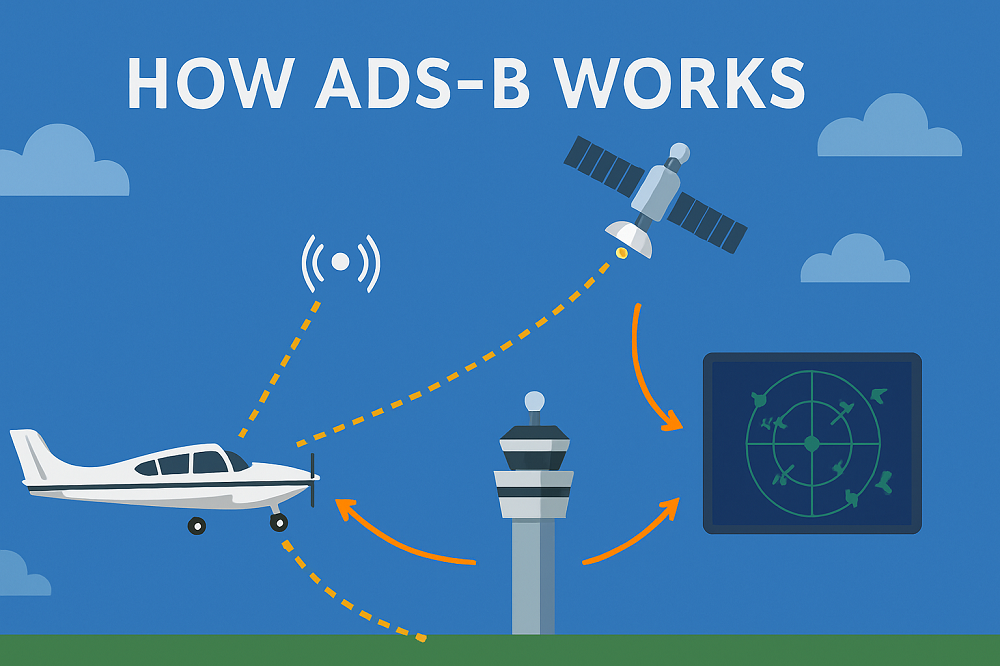Modern aviation depends on clear communication, situational awareness, and real-time data. One of the biggest advances in general aviation safety is ADS-B, short for Automatic Dependent Surveillance–Broadcast. If you’re a student pilot or a newly certified private pilot, you’ve probably heard of it. But do you really know how it works and why it matters?
What Is ADS-B?
ADS-B stands for:
- Automatic: It broadcasts without pilot input.
- Dependent: It relies on GPS data to determine position.
- Surveillance: It allows others (ATC and aircraft) to monitor the aircraft’s position and movement.
- Broadcast: It sends that data out to anyone listening.
Essentially, ADS-B is a satellite-based system that automatically broadcasts your aircraft’s position, altitude, velocity, and other information once per second. That information can be picked up by Air Traffic Control (ATC), other aircraft, and even apps on your tablet or phone.
Why ADS-B Was Introduced
Before ADS-B, air traffic control relied on radar and voice communication. This system worked well but had some limitations:
- Radar coverage is limited in remote areas or at low altitudes.
- Radar updates can take several seconds.
- Controllers must verbally pass traffic advisories.
- Pilots in uncontrolled airspace had limited awareness of other aircraft nearby.
ADS-B addresses all of these problems by providing real-time, satellite-based tracking and communication. The FAA mandated ADS-B Out for most controlled airspace starting January 1, 2020, to improve airspace safety and efficiency.
The Two Types of ADS-B
There are two key components to the ADS-B system:
1. ADS-B Out
This is the part that broadcasts your aircraft’s data. It sends out your position, altitude, velocity, and ID (tail number) once every second. This data can be received by ATC and other aircraft with the proper equipment.
ADS-B Out is required to fly in most controlled airspace, including:
- Class A, B, and C airspace
- Above 10,000 feet MSL (excluding under Class B airspace)
- Within 30 nautical miles of major airports (Mode C veil)
- Class E airspace above 10,000 feet MSL over the 48 states
If your aircraft is not equipped with ADS-B Out, you cannot legally enter these airspaces without prior approval.
2. ADS-B In
This is the part that receives data from other aircraft and ground stations. It allows you to see traffic, weather, and other flight data on your display or tablet. ADS-B In is not required, but it offers big benefits for safety and situational awareness.
Many pilots fly with a combination of both systems. If your aircraft only has ADS-B Out, you’re complying with the rules but not benefiting from traffic or weather info unless you use an external receiver (like a portable unit connected to a tablet).
How ADS-B Improves Safety
1. Better Traffic Awareness
With ADS-B In, you can see other aircraft on a moving map in real time. You know their position, altitude, and direction instantly. This is especially helpful near busy airports or in uncontrolled airspace, where ATC may not provide traffic advisories.
You can visually track targets and avoid potential conflicts much sooner than with radio-only communication.
2. Free Weather and Flight Info
The FAA broadcasts free weather data (called FIS-B) over ADS-B:
- METARs and TAFs
- NEXRAD radar images
- TFRs and NOTAMs
- Winds aloft and turbulence reports
You don’t need a data plan or cellular service to access it. This is incredibly useful for VFR pilots who want to stay updated without relying on in-cockpit Wi-Fi or cell coverage.
3. Enhanced Search and Rescue
ADS-B transmissions can help locate a downed or missing aircraft. Because it updates once per second and provides GPS position data, search teams can narrow down a much smaller area compared to radar tracking.
4. More Efficient Airspace Use
ATC can manage traffic more efficiently with ADS-B. It allows for more direct routing and better separation in remote areas. Pilots benefit from smoother, more predictable flights, especially during cross-country and IFR operations.
Common ADS-B Configurations
There are a few ways general aviation pilots equip for ADS-B:
1. Installed ADS-B Out Only
- Required for controlled airspace.
- No access to traffic or weather unless paired with a separate receiver.
- Usually integrated with a Mode S transponder and GPS source.
2. Installed ADS-B Out + In
- Ideal setup for both compliance and safety.
- Often displayed on panel-mounted avionics or glass cockpit systems.
- Requires a compatible GPS and display.
3. Portable ADS-B In Receiver
- No installation needed.
- Receives traffic and weather (FIS-B) but does not transmit position.
- Common brands include Stratus and Sentry, often used with ForeFlight.
Do I Need ADS-B?
As a student or private pilot, the answer depends on where you plan to fly.
You need ADS-B Out if you intend to operate in any of the following:
- Class A, B, or C airspace
- Above 10,000 feet MSL (except in mountainous regions below 2,500 AGL)
- Within the Mode C veil (30 NM radius around major airports)
- Above Class C airports or over busy metro areas
If you’re flying strictly in Class G (uncontrolled) or rural Class E below 10,000 feet, ADS-B is not required. But many flight schools and aircraft owners install it anyway to future-proof their planes and benefit from the safety advantages.
How to Use ADS-B in the Cockpit
Here’s a basic workflow for using ADS-B in flight:
- Before You Fly
- Check your equipment is working.
- Verify GPS position and signal.
- Confirm settings like aircraft ID and squawk codes.
- In the Air
- Monitor traffic on your display or tablet.
- Cross-check visual and instrument references.
- Use weather radar overlays for planning deviations.
- Maintain good visual scanning and radio communication habits.
- After Landing
- Review your flight data (some systems log GPS tracks).
- Note any alerts or connection issues.
- Consider sharing traffic observations with other pilots during debriefs.
Tips for Student and New Pilots
- Practice with Simulators: Some flight apps and desktop simulators include ADS-B emulation. Use this to get familiar with symbols, alerts, and how to interpret traffic.
- Understand Its Limits: Not all aircraft broadcast ADS-B. Some still use older transponders. Also, UAT-based systems may not show all traffic unless paired with a compatible receiver.
- Stay Alert: ADS-B is a supplement, not a replacement for see-and-avoid. Keep your head outside the cockpit.
- Ask Questions: If your aircraft has ADS-B, ask your CFI to walk through it. Learn how it integrates with your GPS or glass cockpit.
Final Thoughts
ADS-B is one of the most impactful safety technologies available to general aviation pilots. It enhances your situational awareness, provides real-time traffic and weather information, and makes flying safer and more efficient.
As a student or private pilot, taking the time to learn how ADS-B works and how to use it correctly is one of the best things you can do for your own safety. Whether you fly with a full glass cockpit or a tablet on the yoke, ADS-B brings modern tools within reach.
Stay current, fly informed, and make the most of this game-changing technology.
Sources:
– FAA: *ADS-B Overview & Equipment Requirements*
– AOPA: *ADS-B Made Easy*
– ForeFlight: *Using ADS-B In Flight*
– FAA Advisory Circular 90-114: *ADS-B Operations*
– Garmin: *ADS-B Solutions for General Aviation*
Recent Posts
From Paper Charts to Digital: The Evolution of Navigation in the Cockpit
For decades, pilots relied on paper charts, plotters, and manual calculations to navigate the skies. Today, with the tap of a finger, flight plans can be built, modified, and flown using digital maps...
How Synthetic Vision Systems Help Pilots See Through Anything
Imagine flying through dense clouds, over unfamiliar terrain, or during a dark night approach and still having a crystal-clear view of the world outside. That’s what synthetic vision systems offer...


